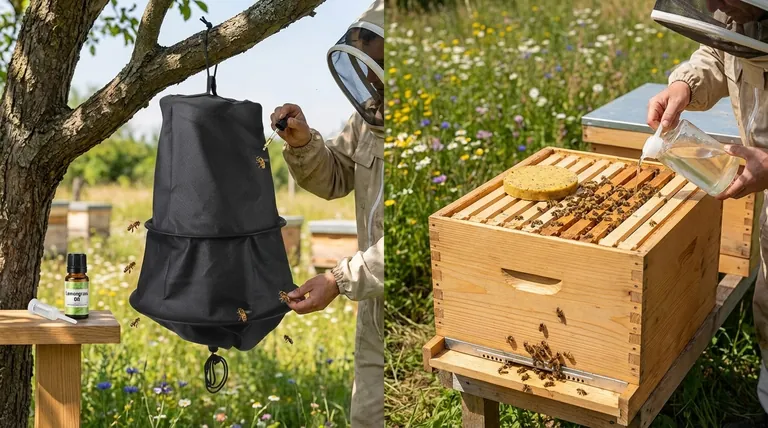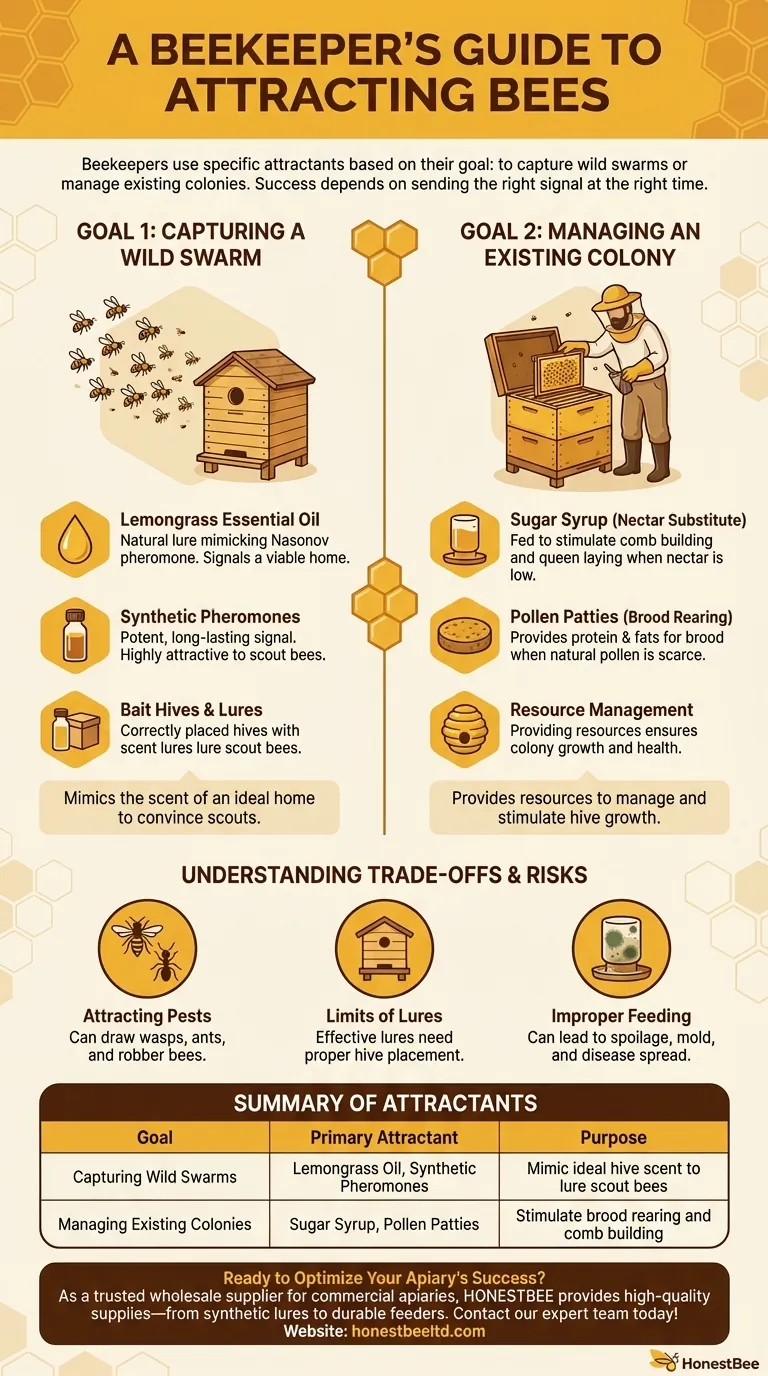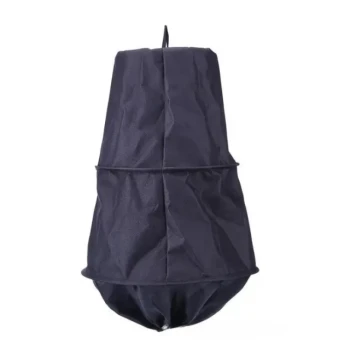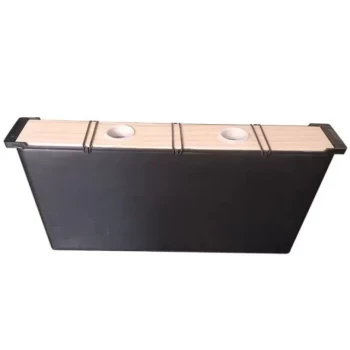At its core, beekeepers use two distinct types of attractants depending on their goal. To capture wild swarms, they use lures like lemongrass essential oil or synthetic pheromones that mimic the scent of an ideal home. To manage and stimulate their existing colonies, they use food sources like sugar syrup and pollen substitutes.
Attracting bees isn't a single action, but a strategy tailored to a specific outcome. The key is understanding whether you are trying to convince a new swarm to move in or encouraging your current colony to thrive.

The Two Primary Goals of Bee Attraction
Beekeepers don't use a one-size-fits-all "bee attractant." The method used depends entirely on whether the goal is to capture a new, wild colony or to manage an existing one.
Goal 1: Capturing a Wild Swarm
When honey bees outgrow their hive, they swarm, sending out scout bees to find a new home. Beekeepers use "bait hives" with specific lures to convince these scouts that their box is the perfect location.
Using Pheromone Lures
The most effective attractants mimic the Nasonov pheromone, a "come here" signal released by worker bees to orient returning foragers and guide swarms to a new home.
Lemongrass Essential Oil
Lemongrass oil is a popular and natural lure because its primary chemical component, citral, is a close match for the Nasonov pheromone. A few drops inside a bait hive can signal that the location is viable and has been approved by other bees.
Synthetic Swarm Lures
For a more potent and longer-lasting signal, beekeepers often use commercially available synthetic pheromone vials. These products are engineered to release a precise and consistent scent that is highly attractive to scout bees, often proving more effective than essential oils alone.
Goal 2: Managing an Existing Colony
The second form of "attraction" is not about luring bees from afar, but about providing resources to manage and stimulate the hive you already have. This is done through strategic feeding.
Sugar Syrup as a Nectar Substitute
Beekeepers feed bees a 1:1 or 2:1 solution of sugar-to-water to supplement or replace nectar. This is done when natural nectar flow is low, to help a new colony build comb, or to encourage a queen to lay eggs by simulating an abundance of resources.
Pollen Patties for Brood Rearing
Pollen provides the protein and fats bees need to raise their young (brood). When natural pollen is scarce, beekeepers provide pollen substitutes, often in a patty form, to ensure the colony can continue to grow and raise the next generation of bees.
Understanding the Trade-offs and Risks
Using attractants—whether scent or food—is not without potential downsides. A successful beekeeper understands how to mitigate these risks.
Attracting Unwanted Visitors
Both swarm lures and open feeding can attract more than just honey bees. Wasps, ants, and bees from other hives (robbing bees) can be drawn in, creating competition and stress. This is why feeders should be placed carefully and any spills cleaned immediately.
The Limits of a Lure
A good lure is only one part of capturing a swarm. The bait hive itself must be the right size, placed at the correct height, and positioned properly in the landscape. A lure in a bad location will not work.
Dangers of Improper Feeding
Feeding comes with responsibilities. Leaving large quantities of feed can lead to spoilage and mold. Furthermore, if not done correctly, feeding can encourage the spread of disease within a hive or between different colonies in the area.
Making the Right Choice for Your Goal
Your strategy must be aligned with your objective. There is no single "best" way to attract bees; there is only the best way for your specific situation.
- If your primary focus is capturing a wild swarm: Use a dedicated swarm lure like a synthetic pheromone vial or lemongrass oil inside a properly sized and placed bait hive.
- If your primary focus is stimulating an existing colony to build comb: Use a 1:1 sugar syrup feed inside the hive to mimic a strong nectar flow.
- If your primary focus is supporting brood production during a pollen shortage: Provide a high-quality pollen patty directly to the colony.
Ultimately, effective bee attraction is about sending the right signal—a new home or a full pantry—at precisely the right time.
Summary Table:
| Goal | Primary Attractant | Purpose |
|---|---|---|
| Capturing Wild Swarms | Lemongrass Oil, Synthetic Pheromones | Mimic ideal hive scent to lure scout bees |
| Managing Existing Colonies | Sugar Syrup, Pollen Patties | Stimulate brood rearing and comb building |
Ready to Optimize Your Apiary's Success? As a trusted wholesale supplier for commercial apiaries and distributors, HONESTBEE provides the high-quality beekeeping supplies and equipment you need—from synthetic lures to durable feeders. Let us help you enhance swarm capture rates and hive productivity. Contact our expert team today to discuss your specific needs and explore our wholesale solutions!
Visual Guide

Related Products
- HONESTBEE Collapsible Tiered Bee Swarm Catcher for Beekeeping
- Styrofoam Mini Mating Nuc Box with Frames Feeder Styrofoam Bee Hives 3 Frame Nuc Box
- Professional Insulated Plastic Bee Hives
- Plastic Transporting Bee Packages and Nuc Boxes for Beekeeping
- Twin Queen Styrofoam Honey Bee Nucs Mating and Breeding Box
People Also Ask
- How to attract bees to a hive box? Proven Methods for Swarm Capture & Colony Expansion
- What are the three main ways to obtain honeybees? Choose the Best Path for Your Apiary
- What information should be gathered before attempting to catch a swarm of bees? A Safe and Successful Guide
- What is the typical method for moving a swarm of bees? Capture the Queen for a Safe & Easy Transfer
- Do honey bees leave their hives? Understanding the Critical Role of Swarming



















